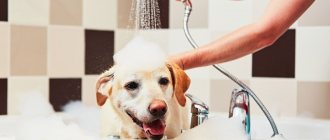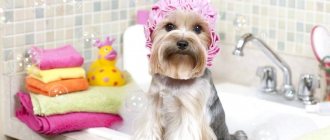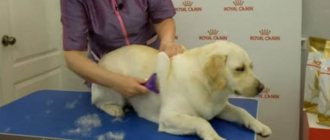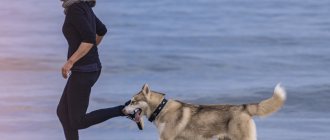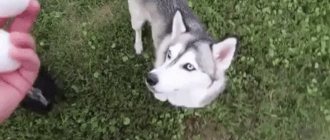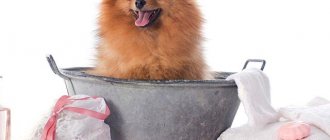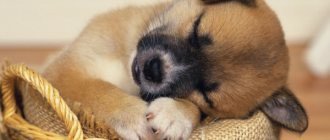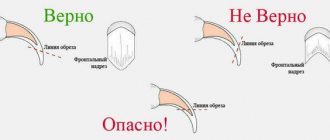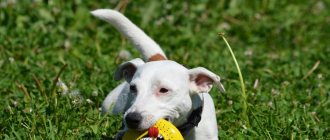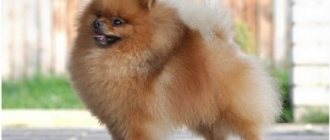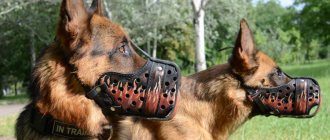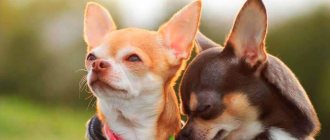How to care for a dog, what conditions will be optimal and how to provide them - these are questions that need to be asked before purchasing a pet. If you have already chosen your baby and are planning to take him home, it makes sense to know when to bathe your puppy for the first time. There are no strict restrictions in this matter, but you should still listen to the recommendations of experienced breeders.
When can you start washing your puppy?
When you can bathe a puppy for the first time is a moment that any owner of a furry animal needs to know. The fact is that kids love to learn new things, getting into all the secret, especially dusty corners. Even if you are at home and not going outside, your dog can still get very dirty.
Puppy's first bath
For your information! Most experts recommend not resorting to water procedures before the dog is 3 months old.
The circumstances under which the dog finds itself in the hands of its new owner have a big influence on when you can wash the puppy. For example:
- If the baby was picked up on the street, before allowing him to run around the house, the pet must be bathed. Especially if this happens in the summer, when the animal may have not only dirt, but also insects and parasites. With a high degree of probability, one shower will not do the job. You will need to use special anti-flea cosmetics;
- If a pet grew up without a mother and a person had to feed it on their own, there is no need to rush into a bath. Sometimes you can simply wipe your dog with a damp cloth. This is due to the fact that the puppy did not receive mother’s milk; accordingly, its immunity is less developed, and premature water procedures can lead to diseases. This situation applies to both small dogs, such as Spitz and Yorkies, and large breeds such as huskies and German shepherds;
- if a purebred dog, for example, a Labrador, was purchased from a breeder, then the rules of care are standard. It is best not to resort to water treatments before the puppy is 3 months old. On the other hand, purchasing from an official breeder or nursery means that all the necessary vaccinations for the baby have already been completed, which means that if there is really a need, you can still give the puppy a bath.
A bath is needed if the baby gets dirty
At what age the puppy can still be bathed, the owner will have to decide for himself. If the little mischief managed to get dirty somewhere, of course, he will have to be bathed, even if he has not yet received the necessary vaccinations. In a normal situation, you can refuse baths.
Don't neglect water treatments
Bathing is an important procedure for a puppy. The owner must be aware that cleanliness of the coat and skin protects the pet from diseases and parasites. Some of the most common insects found in puppies include ticks and fleas.
There are many benefits of water procedures. The most significant ones include:
- cleanliness of fur and absence of fleas;
- neat appearance of the puppy;
- no unpleasant odor;
- reducing the risk of lichen and other skin diseases.
However, frequent water treatments can harm your pet by washing away the protective fatty lubricant. Therefore, you should not wash the puppy after every walk; it is better to carry out this procedure as needed.
The benefits of water procedures
In some cases, if the bathing procedure is performed incorrectly, liquid and detergents get into the puppies' ears and eyes.
This can lead to hearing and vision problems. Therefore, special care must be taken. Important! Each breed of dog may have individual characteristics that are recommended to be observed during bathing.
How to wash a puppy
How often can you wash your dog and puppy with shampoo?
Having decided when to wash the puppy for the first time, the owner is faced with a second, no less important question: what is the best way to do this.
Note! The animal's body is covered with a special lubricant that is secreted from the sebaceous glands. Using ordinary water, the owner will be able to wash off only the top layer of dirt.
Accordingly, sebaceous grease cannot simply be washed off without the use of shampoo. However, it needs to be cleaned periodically. However, you cannot use regular products intended for people. Animals need special shampoos that are suitable for their body.
It is important that many dogs, in addition to water treatments, also require daily or regular fur care. This applies to breeds such as the Yorkshire terrier, cocker spaniel, husky, and, in principle, any long-haired dog.
As for short-haired dogs, such as Chihuahuas, the situation with them is somewhat different. They can be combed periodically, but trimming will have to be done regularly. It all depends on the type of animal that is kept in the house.
Choosing a Shampoo
The choice of animal hair care product should be approached responsibly. The fact is that special dog shampoos are very different from cosmetics for people, in particular, this concerns their composition.
First of all, dog shampoo contains no fragrances or dyes, which are found in abundance in cosmetics for humans. They do not contain any additional additives at all. All this can negatively affect the skin and fur of the animal.
For your information! Cosmetics for pets are designed specifically for cleaning fur, not hair.
A truly high-quality shampoo can be quite expensive. However, one tube lasts a long time, since dogs are rarely bathed more than 1-2 times a month. Some dogs take baths only 2 times a year or as needed.
When buying shampoo for the first time, you should carefully choose. It is necessary to take into account the age of the animal, the type of coat, as well as the main purpose. There are special remedies for parasites.
Important! Representatives of different breeds require different cosmetics. You cannot use the same shampoo for both your dachshund and your chow chow. If it is difficult to find the right shampoo, it is recommended to consult a veterinarian.
Using special dog shampoo
Vaccination schedule
Caring for a purchased or found puppy, of course, will involve more than just feeding and bathing. Your pet must have up-to-date vaccinations. For the first time, puppies of almost all breeds are vaccinated at 1.5-2 months. Children are vaccinated against distemper at this time.
In the future, the pet vaccination schedule will most likely look like this:
- second vaccination - 2 weeks after the first (distemper);
- third vaccination - at 6 months, after changing baby teeth (against rabies).
Subsequently, puppies are usually vaccinated once a year. At two months, dogs of predisposed breeds can be vaccinated not only against distemper, but also against diseases such as parvovirus enteritis, infectious hepatitis, parainfluenza, and leptospirosis. In all these cases, the procedure is repeated after two weeks.
Preparing to bathe a puppy
Feeding puppies: when can you feed them?
How to bathe a puppy? For the first time, this procedure can cause a lot of problems, especially if this is the person’s first pet. To wash your baby, you need to prepare:
- a shallow basin suitable for the size of the pet;
- rubber mat;
- a comb with long teeth;
- a special brush for fluff;
- separate container for shampoo;
- coat conditioner (optional, optional, suitable for long-haired breeds);
- towels, 2 pcs.;
- hairdryer
Note! The water should be at the right temperature - not too cold and not too hot. For greater convenience, it is recommended to get a thermometer. The approximate water temperature should be from 36 °C to 40 °C.
If your dog has long hair, before starting water treatments, you need to comb the fur well. Be sure to remove all tangles and stuck plants (burdock, for example). The bottom line is that after a bath, doing this will be much more problematic and difficult. Wet fur will be difficult to comb, and the process itself will cause pain to the pet.
Your dog needs to be brushed before bathing.
At what age should you introduce water?
When we bring a puppy into our home, it is usually 7-9 weeks old. A change of place of residence, caretakers, the presence of other animals in the house, food served differently and many new smells - all this is a huge stress for such a baby. Another problem is the high susceptibility to disease.
If a puppy drinks its mother's milk, the immunity it was given gradually disappears, while preventive vaccinations are not yet completed. Therefore, there is a much greater risk of developing infection than in older dogs. For these reasons, we should wait to give him his first bath until he is a little older and more stable.
The situation for older animals is completely different. When the traveler has settled with us and feels confident in his new home, when vaccinations and deworming are completed, it is time to take a bath. The only question is, is it necessary?
Bathing process
When can you walk your puppy after the second vaccination?
Regardless of what breed the dog is (or may be mongrel), it needs to be bathed according to the same scheme. Actions are carried out in the following order:
- The puppy is taken under the belly and gently immersed in a bowl of water. You shouldn't do this abruptly. Moreover, you don’t need to grab the dog by the scruff of the neck.
- After the dog is in the water, you should wait a little. Let the baby get used to his feelings and calm down.
- Lightly moisten the wool using a separate container or by collecting water in your palm.
- Pour shampoo onto the back of the animal. To begin with, use a small amount.
- While stroking, lather the product. You can talk to your pet and say how great he is.
- Rinse off the shampoo. You can use a separate ladle or turn on the shower. In the latter case, a weak set is necessarily used so as not to frighten the animal or hurt it.
- After all the shampoo has been washed off, the puppy is taken out of the basin and wrapped in a towel. The fur is well wiped and dried with a hairdryer.
It is best to bathe puppies in a basin.
What to do if your dog is afraid to bathe
If the dog does not like washing, you need to analyze the reasons why the dog does not want to bathe and eliminate it. It can be:
- The sound of water. To solve the problem, do not bathe your dog in the shower, but fill several buckets in advance and collect water from there.
- Slippery bottom due to feeling of instability. A towel or rubber mat will solve the problem.
- Shampoo smell that can dull the sense of smell. Buy a detergent without fragrance.
Treats and praise will help reconcile the dog with washing. Reward your pet every time he comes to the bathtub. When he stops being afraid, put him in a dry bath, without water, not forgetting to praise him and give him treats. Then you can move on to gently soaking with water, rewarding after the first drops hit.
How often to wash puppies
A separate item concerns the question of how often puppies and adult dogs should be bathed. It really all depends on the breed and coat type. In addition, the time of year, weather conditions and where exactly the furry friend is kept matter. In other words, there is simply no single answer.
Important! If your pet lives on the street, regular water treatments will be problematic, to say the least, and even pointless. Another question is if the dog is in an apartment and only goes outside for a walk.
In the summer, a large amount of dust and dirt accumulates on the animal’s fur, which, during the licking process, then enters the dog’s stomach. It seems that in this case it is necessary to bathe the dog as often as possible. However, do not forget that in the process of washing the animal’s body is washed off the sebaceous layer, which is a kind of protection from getting wet. Accordingly, in rainy weather the pet gets wet faster and may catch a cold.
In addition, contrary to popular belief, short-haired dogs need to be washed much more often than long-haired dogs. The point again is the lubricant that their body secretes. Most experts recommend performing water procedures at least once a month. However, this should also be taken with a grain of salt.
Important! If a dog comes home dirty from the street or comes from the forest, of course, he will need a bath. If the pet belongs to a breed for which frequent bathing is contraindicated, it should not be abused.
How to wash a puppy's paws
Of course, you don’t need to wash your pet after every walk outside. The only exception is if the pet managed to find a very deep and attractive puddle. What you really need to do after going outside is to wash your pet's paws.
This can be done either with regular warm water or with shampoo. It all depends on the degree of pollution. During dry seasons, you can generally wipe your paws with a damp towel.
After a walk, wash your paws
A separate recommendation for dogs with a beard, such as the Miniature Schnauzer. In addition to their paws, they also need to wash their beard after a walk. In any case, an animal on the street will sniff grass, earth and everything possible. Of course, a variety of germs and dirt accumulate on the long fur of the chin.
Therefore, the beard must be washed along with the paws. You can also rinse with clean warm water. After the procedure, everything is wiped with a dry towel. There is a separate line of pet cosmetics specifically for paws and beards. These can be used at least every day. They do not have a negative effect on fur and skin.
Important! Having chosen one remedy, it is best to use it. You should not buy different drugs every time, under different brands.
Tips for teaching a puppy to bathe
In most cases, training your dog to take a bath is not that difficult. Unlike cats, they do not have a phobia. However, if this is the baby's first time, it is best to prepare him in advance. In order for the dog to react more calmly to a new environment for him, before washing him at all, it is worth introducing the animal to the bathroom.
So far this is done without water. The dog is simply placed in a bath, shower or basin, that is, where it will subsequently be washed. Let your pet just look and smell everything. At the same time, you should speak to your pet gently, but firmly, stroking the back and head.
The first time you wet the fur you need to be very careful. The fur is watered with water from your hands or a separate ladle and massaged. It is necessary that the liquid reaches the animal’s skin. It is very important to ensure that moisture and shampoo do not get into your dog’s nose, eyes and ears.
The procedure itself is quite simple and straightforward. By following it, a person can easily avoid unpleasant consequences. After the procedure, the puppy must be dried. First, the fur is dried with a towel, and only then a hairdryer is used.
Note! The hair dryer should be used with caution and never turn the device on to maximum heat. Otherwise, you can simply burn your pet's skin. By the way, the puppy should also be introduced to the drying device in advance, otherwise the dog may simply get scared by the loud noise.
Water procedures are important and necessary for dogs; pet owners should not forget about this. It is also important to follow the basic rules, especially for small puppies for whom bathing is the first time in their lives. Everything is done without haste and according to instructions. In this case, the dog will be bathed and happy, and the owner will not be bitten.
Features of washing large breeds
Large dogs are much more difficult to bathe than small dogs due to the large amount of fur. To wash large animals you will need a huge container, a lot of water and about 15 minutes of time.
Large dogs usually love water, so problems with washing arise only at the stage of accustoming them to watering cans, shampoos and brushing. Start training and developing pleasant emotions from hygiene as early as possible, from 2-3 months. Wash your dogs completely often in the warm season, less often in winter due to the high risk of colds.
If the dog is shaggy, comb it before taking a bath and cut off any tangles. Wet the wool generously so that the moisture penetrates all the way to the skin.
First, wash your back, stomach, paws with shampoo, then your chest and head. Monitor the water temperature and the direction of the stream. Try not to get foam into your pet's mouth and eyes . This can cause burns to the mucous membrane and poisoning.
Keep the shampoo on the coat for another 5 minutes after massaging, then rinse with clean water 3-4 times. To dry the body of a large pet, prepare several bath towels, one for blotting, the other for natural drying.
In summer, it is more convenient to bathe large dogs outside.
Do not stop the dog from shaking itself, this is a reflex. If you use a hair dryer to dry the coat, brush your dog with a soft brush, otherwise tangles will form.
To eliminate the unpleasant dog odor, use special shampoos. You can prepare your own rinses: a decoction of burdock, wormwood, or a mixture of both herbs. It is better to buy plants at a pharmacy or collect them away from highways.
Immediately after bathing, praise your pet for good behavior and give him a treat. This will help develop a positive association with the procedure.
